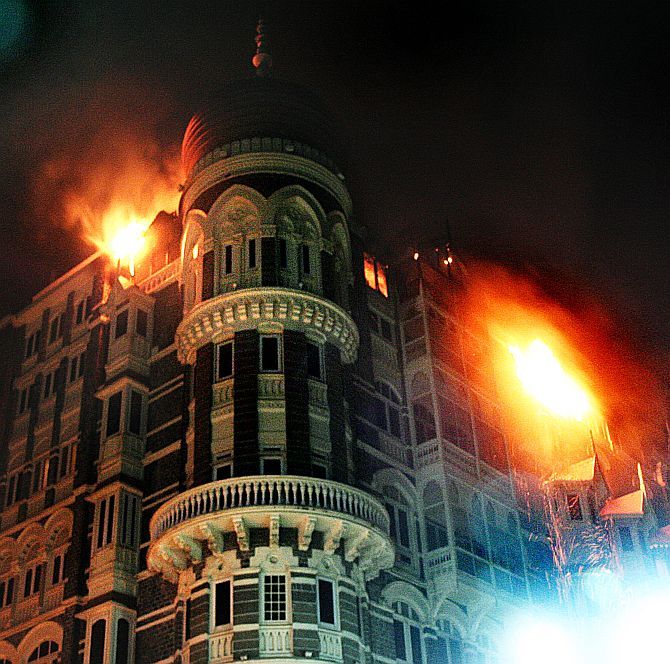 | « Back to article | Print this article |
Could Mumbai have been saved from terror on November 26, 2008? Perhaps, had the intelligence agencies of India, United States and Britain worked together to put together bits of crucial data that came their way, reveals an investigation conducted by The New York Times, ProPublica and the PBS programme, Frontline.
All the technology in the world at their disposal, yet the inability to piece together crucial chunks of intelligence led to the loss of 166 lives in the bloody carnage unleashed by Lashka-e-Tayiba terrorists on Mumbai between November 26 and 29, 2008, it has now been revealed.
An investigation by The New York Times, ProPublica and the PBS series Frontline has discovered that despite sensing a threat from the Lashkar to Mumbai at least two months before the November 26 attacks, the joint intelligence units of the United States, Britain and India did little to prevent it.
The report notes how British intelligence agencies tracked the web activity of Zarar Shah, the chief of Lashkar's media operations, in mid-September 2008.
Shah and his co-conspirators used Google Earth and other material to show Pakistani terrorists the targets and attack routes in Mumbai.
Shah searched for Sun Tzu's Art of War, previous terror strikes in India and weather forecasts in the Arabian Sea, typed '4 star hotel in delhi' and 'taj hotel,' and visited mapsofindia.com to pore over sites in and around Mumbai, the documents disclosed by Edward J Snowden show.
The Indians did not home in on the plot even with the alerts from the United States, the report said.
Among the most significant clues "slipped" by the Americans was related to Pakistani-American David Headley, who had scouted targets in Mumbai for the attacks and exchanged incriminating emails with plotters that went unnoticed until shortly before his arrest in Chicago in late 2009.
US counterterrorism agencies also did not pursue reports from his unhappy wife, who told American officials long before the killings began that he was a Pakistani terrorist conducting mysterious missions in Mumbai, the report said.
"We didn’t see it coming," a former top US intelligence official said. "We were focused on many other things -- Al Qaeda, Taliban, Pakistan's nuclear weapons, the Iranians. It’s not that things were missed — they were never put together."
Meanwhile, the British agencies intercepted Shah's dealings with Callphonex, a New Jersey company selling voice-over-Internet service (which the Lashkar terrorists would use to mask their location during the 26/11 attacks).
This is where the chain of intelligence disasters begins.
'(On October 22), as he made his plan, he searched on his laptop for weak communication security in Europe, spent time on a site designed to conceal browsing history, and searched Google News for 'indian american naval exercises' -- presumably so the seagoing attackers would not blunder into an overwhelming force,' the report said, quoting sources.
The British and Indians, who also had a whiff of Shah's activities, never shared intelligence on the Lashkar terrorist.
The New York Times reported, 'Britain and India, while cooperative, were not nearly as close as the United States and Britain. And India is not included in the tightest intelligence-sharing circles of international, eavesdropping agencies that the two countries anchor.'
'Intelligence officials say that terror plots are often discernible only in hindsight, when a pattern suddenly emerges from what had been just bits of information. Whatever the reason, no one fully grasped the developing Mumbai conspiracy.'
An alert on November 18 reported the location of a Pakistani vessel linked to a LeT threat against the southern coastal area of Mumbai, where the attack would occur.
By November 24, Shah had moved to the Karachi suburbs, where he set up an electronic "control room" with the help of an Indian militant named Abu Jundal, according to his later confession to the Indian authorities. It was from this room that Mir, Shah and others would issue minute-by-minute instructions to the assault team once the attacks began.
The report said after the assault on prime Mumbai targets began by the 10 LeT terrorists, the three countries quickly disclosed their intelligence to one another, including monitoring a LeT control room in Pakistan where the terror chiefs directed their men, hunkered down in the Taj and Oberoi hotels and the Jewish hostel, according to current and former American, British and Indian officials.
That cooperation among the spy agencies helped analysts retrospectively piece together "a complete operations plan for the attacks," a top-secret NSA document said.
'They either weren't looking or didn't understand what it all meant,' said one former American official who had access to the intelligence.
Shivshankar Menon, who was India's foreign secretary at the time of the attacks and later became the national security adviser, told the US newspaper, 'No one put together the whole picture. Not the Americans, not the Brits, not the Indians. Only once the shooting started did everyone share what they had, largely in meetings between British and Indian officials, and then the picture instantly came into focus.'
A lesson that emerged from the tragedy in Mumbai was that 'computer traffic only tells you so much. It's only a thin slice.'
The key is the analysis, Menon said, and 'we didn't have it.'